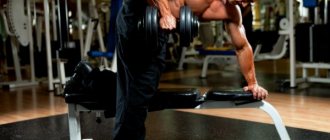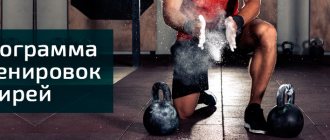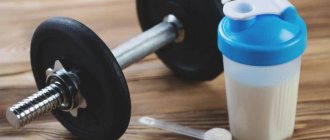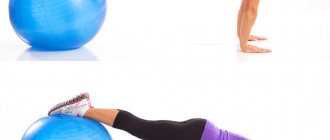Basic exercises
Why basic exercises? Firstly, because they are more natural for our osteoarticular framework. And secondly, these exercises create a better brain-muscle connection (better neuromuscular connection).
Why are they more natural? Because they involve multiple joints, which means that in these movements you are stronger on one hand, and on the other hand, you are more comfortable doing them than in those exercises in which you are limited to working only one joint.
The nervous muscle connection works better in such exercises, because more muscles contract (more joints are involved in the work), accordingly, the “brain-muscle” connection works better in such exercises.
In basic exercises for beginners, mental connection, the “brain-muscle” connection, is very important.
https://youtu.be/TFQ4rMMRpXk
Muscle failure
What is a refusal? Failure is the inability to independently perform one more repetition with correct technique. When performing an exercise, with each repetition your strength runs out, and there comes a moment when your strength is exhausted, and with exactly the same technique you are no longer able to perform another repetition. You have experienced a failure, you have run out of energy. Failure is very important in this bulking training program, failure means that you have run out of the necessary energy to continue working out. The fact that you have run out of energy is one of the main incentives for starting further muscle growth.
It is best for failure to occur within 15-30 seconds. Because if a failure occurs in this interval, it will mean that the resynthesis of energy from anaerobic glycolysis, from an alternative method of energy supply, has not reached sufficient capacity to cover the costs. This will lead to injuries to muscle fibers, to the destruction of your protein structures, which will subsequently lead to their healing, restoration to the original level, and if you do everything correctly, then to super recovery, super compensation, that is, fiber growth in a larger volume than it was before failure. Therefore, failure is a way of depleting your energy to a level sufficient to cause the necessary destruction, which will then lead to the necessary growth. In this regard, failure in this training program for bulking is very important.
Progression of loads
Now let's focus on another important thing, this is the progression of loads in training according to this program for gaining weight.
Why are we raising this issue? Because the principle of load progression is a fundamental principle in any speed-strength sport that uses your muscles. The principle of load progression means that the load on your muscles increases. If the load on your muscles does not increase, then your muscles have no reason to change and increase in response to this load. That is, the point of progression is to increase the load on your muscles and force them to grow. People can go to the gym for decades and not achieve anything because they don't have this progression. In this regard, when we talk about progression, we will talk about the diary. A journal is required when training with this weight gain training program. Because the diary will allow you to follow the principle of load progression.
Easy/Hard Training Method
Want to learn how to vary your hard and easy workouts? Then read the article “Method of varying training based on the easy/hard principle”...
There is such a method of varying the load as the “light - heavy” method, which in turn consists of being able to vary and alternate the training volume and load in each of your workouts.
In this case, varying and changing the load itself can be achieved in two ways. The first is to alternate light training with heavy training along with all the exercises taken.
The second is to use alternation of, say, separate exercises, performing exercises with heavy working weights in one workout, and in the next training session, work in the same exercises, but with lighter working weights.
I would like to note that this method is used not only by all powerlifters, but also by many bodybuilders, thereby preventing their body from driving itself into overtraining, and also allowing itself to rest or work on technique in some basic strength exercises.
Moreover, the difference between heavy and light training is, as a rule, only 20% - 30% (40%), i.e. in a light workout, you work with weights of 70% - 80%; in extreme cases, it can be even smaller working weights, for example, 60% - 70% of the weight that you planned for your heavy workout, but everyone has the right to choose their own working weights weights with which it will be more convenient and comfortable for him to work.
This method helps not to overload the central nervous system (CNS), but it also gives longer rest not only to the muscles, but to the entire body as a whole.
Varying light and heavy workouts Let me give you an example: let’s say if your microcycle consists of two workouts that alternate with each other as in program 1 “Super-abbreviated training”, then your training scheme will look like this:
Program No. 1 “Super abbreviated training”
Option 1 T, T - L, L - T, T - L, L...... and so on
Option 2 T, L - L, T - L, L - T, L - L, T - L, L...... and so on
The same applies to other microcycles, which also include a larger number of training days in such, for example, program 2 “Abbreviated training”. In which not 2 training days are used, as was the case in the previous program, but as many as 4 training days, which also constantly alternate with each other.
Program No. 2 “Abbreviated training”
Option 1 T, T, T, T - L, L, L, L...... and so on
Option 2 T, L, T, L - L, T, L, T - T, L, T, L - L, T, L, T...... and so on
Option 3 T, T, L, L - L, L, T, T - T, T, L, L - L, L, T, T...... and so on
Option 4 T, L, T, L - L, T, L, L - T, L, T, L - L, T, L, L...... and so on
T - hard training. L - easy training.
Using this principle, it will be possible to work in absolutely any microcycles, but this method is only suitable for experienced athletes; if you are still a beginner, then you can forget about it for a long time.
At the same time, there are quite a lot of such options for alternating light and heavy training; some powerlifters also add medium training to their light and heavy training.
It turns out not a hard and easy workout, but a hard, medium and easy workout. Moreover, the difference between all these workouts is approximately 15% -20%.
- Heavy training 100% working weight
- Average workout 80% working weight
- Light workout 60% working weight
This option of alternating your workouts promotes better recovery between main hard workouts.
In this case, they can be located in the following orders:
- Heavy - medium - light
- Heavy - light - medium
This load distribution is called the wave principle of periodization, which is mainly used only by very experienced athletes.
For all beginners and amateurs with less than 6-8 years of training experience, I advise you to train according to the “Stepped Periodization Method”, when working weights increase in each workout, while your working repetitions in each subsequent workout are constantly decreasing until you reach to its maximum.
Microperiodization
We will also be using microperiodization in this muscle building program. This is a useful and effective remedy that will help us increase muscle mass.
Microperiodization is the alternation of training. Roughly speaking, alternating light workouts with hard workouts. A week - heavy, a week - light, heavy, light... etc.
The thing is, after a hard workout on your muscles, they are destroyed, they need a week to recover, and then another week for super recovery, super compensation, to grow. That is, our contractile proteins and damaged fibers usually take quite a long time to recover after a severe failure workout - two weeks. The terms are conditional - for some a little less, for others a little more, but the process is very long. That is why we train large muscle groups in Mentzer training quite rarely (once every two weeks, or even once every three weeks), and they grow well. This is because they are given enough rest during heavy workload.
During the first hard week, our muscles are restored, in the second week there is super recovery, super compensation, increased growth, but usually all other functions, such as energy, glycogen reserves in your muscles and others, with such rare training, begin to degenerate, a phase of loss of compensation begins and super compensation. Because they rest too much and begin to lose the benefits they received. That is, these functions need to be trained more often. You train these functions, such as energy, during the easy week.
During the easy week you are also training some degree of hyperplasia of your muscle fibers, as you are delivering a lot of volume with very little intensity, you are achieving a slight burn, a certain amount of hydrogen ions - this all leads to a lot of messenger RNA.
During a light week, muscle growth is no less, if not more intense, than during a hard week. This must be done - use microperiodization.
This scheme allows you to achieve much greater progress than if you used a conventional linear scheme of loads with maximum impact in each workout.
Protein-carbohydrate alternation. How does the body react?
In the first two days, all glycogen reserves are depleted, so the body begins to take energy from fat reserves.
But you should not stick to this diet for a long time, so that the emergency mode does not turn on, when the body will put aside fat reserves in case of a repetition of such a “hunger strike.” Muscle mass will immediately begin to decrease as the body uses it first.
To prevent this from happening, you need a day of high carbohydrate consumption. The daily caloric intake remains unchanged, only the ratio of proteins and carbohydrates changes. The amount of fat is reduced, and carbohydrates increase to the maximum level.
The body becomes confused as it continues to absorb fats and replenish glycogen stores. But it is worth considering that replenishment of reserves will not happen in one day, so on the 4th day carbohydrates continue to be consumed, but not in such high quantities.
After the end of 4 days you need to repeat the cycle.
Stretching the muscle fascia
Fascia is a so-called pouch, a cover in which muscle fibers are stored. Accordingly, the denser this “cover” is, the greater the pressure is created on the muscle fibers, and the harder it is for them to grow in breadth and increase in volume. Purely physical laws are at work here - external pressure prevents fibers and muscle cells from increasing in size. If we remove this external pressure, then it will become much easier for muscle cells and muscle fibers to grow. Therefore, during training it is necessary to stretch the muscle fascia.
Stretching can be done in two ways:
- Mechanical stretching (performing stretching exercises)
- Pumping (filling muscle fibers with blood, resulting in stretching of the fascia, and there is more room for the growth of your muscle fibers)
Fascia has a kind of shape memory, that is, if it is regularly stretched, it will retain the shape it received.
The microcycle of a training program for weight gain will go like this:
- Week 1 – challenging workout
- Week 2 – light training
- Week 3 – challenging workout
- Week 4 – light workout
Etc.
Features of a challenging workout
Heavy training includes some features:
- The weights must be heavy. These are the weights that lead to muscle failure within 6 – 8 repetitions. The main feature of such training is that it is strength training.
- The number of exercises for large muscle groups is about 4 exercises, for small muscle groups it is about 2 - 3 exercises.
The number of working approaches for large muscle groups is 4–5, for small muscle groups 3–4.
- In this case, failure should be present in 2–3 working approaches of each exercise. We are talking about at least a positive refusal, this is a refusal when you yourself can no longer lift an exercise into a positive form (squeeze a barbell, do a biceps curl, do a pull-up).
- There is definitely a stretching of the fascia in the form of pumping. At the end of the workout, we do 2-3 dropsets to stretch this fascia. Stretching is also present during stretching exercises for this particular muscle group between working approaches.
During a hard week, at each hard workout, before performing each working approach, look at the diary in order to understand what the result was in the last hard workout.
This is necessary in order to understand what result you need to surpass in each working approach. This way you will follow the principle of progressive load, and this way they will turn into heavy ones, they will destroy your muscles, and you will be able to monitor and control the process.
You must progress the load, only then will your muscles increase.
The weekly plan looks like this:
- Monday – Back muscles
- Tuesday – Chest muscles
- Wednesday - Rest
- Thursday – Leg muscles
- Friday – Deltoids
- Saturday – Biceps and triceps
- Sunday - Rest
This technique allows us to work on the strength of each part of the body separately, while giving good rest to other muscle groups for a long time.
Monday (challenging back workout)
1. Pull-ups or lat pull-downs 2 warm-up sets, 4 – 5 working sets of 6 – 8 reps. After each working approach, this muscle group is stretched.
2. T-bar row or bent-over barbell row 1 warm-up set, 4 working sets of 6 – 8 reps. Again, stretching in every working approach.
3. Dumbbell rows with one arm, bent over, 3 – 4 working sets on each side, 6 – 8 repetitions. Again, stretching in every working approach.
4. Horizontal block row 3 working sets of 6 – 12 reps. Again, stretching in every working approach.
Next comes stretching the muscle fascia
5. Horizontal pull-down with a small weight 6 sets of 8 - 10 repetitions with a rest of 15 - 30 seconds. Again, stretching in every working approach.
This is done in order to fill your muscles with blood as much as possible and stretch the muscle fascia as much as possible.
Tuesday (challenging chest workout)
1. Bench press on an incline bench (at an angle of 30 degrees) 2 warm-up sets, 4 working sets of 6 – 8 repetitions. Again, stretching in every working approach.
2. Dumbbell press on an incline bench (at an angle of 30-40 degrees) 1 warm-up set, 4 working sets of 6 – 8 repetitions. Again, stretching in every working approach.
3. Dumbbell flyes lying on a bench: 1 warm-up set, 4 working sets of 8 – 10 repetitions. Again, stretching in every working approach.
Next comes stretching the muscle fascia
4. Bench press on a horizontal bench 6 working approaches with light weight with a rest of 15 - 30 seconds. Again, stretching in every working approach.
Goal: exactly the same as on Monday, to achieve a good pump into the muscles, fill them with blood. At the end of the pump, be sure to stretch the muscles well.
Wednesday – rest
Thursday (challenging leg workout)
1. Standing calf press 2 warm-up sets, 4 working sets of 12 – 20 reps. Again, stretching in every working approach.
2. Barbell squats 3 warm-up sets, 4 working sets of 6 – 8 reps. Again, stretching in every working approach.
3. Seated leg extensions 1 warm-up set, 4 working sets of 8 – 15 repetitions. Again, stretching in every working approach.
4. Deadlift on straight legs 2 warm-up sets, 4 working sets of 6 – 8 reps. Again, stretching in every working approach.
5. Lying leg curls 1 warm-up set, 4 working sets of 8 – 15 repetitions.
Next comes stretching the muscle fascia
6. Seated leg extension: 6 working sets of 8-15 repetitions with a rest of 15-30 seconds.
The muscles are filled with blood as much as possible, and be sure to stretch this muscle group well.
Friday (challenging shoulder workout)
1. Classic standing press 3 warm-up sets, 4 working sets of 6 – 8 reps. Again, stretching in every working approach.
2. Barbell row to the chin 1 warm-up set, 4 working sets of 6 – 8 repetitions.
3. Standing dumbbell raises: 1 warm-up set, 4 working sets of 6–8 reps. Again, stretching in every working approach.
4. Bent-over dumbbell flyes: 1 warm-up set, 4 working sets of 6–8 reps.
Next comes stretching the muscle fascia
5. Standing dumbbell flyes Triple drop set, 3 sets.
Saturday (difficult arm workout)
1. Standing biceps curl (biceps curl) 2 warm-up sets, 4 working sets of 6 – 8 repetitions. Again, stretching in every working approach.
2. Close-grip press or dips (triceps) 2 warm-up sets, 4 working sets of 6 – 10 reps. Again, stretching in every working approach.
3. Hammer (biceps) 1 warm-up set, 4 working sets of 6 – 8 repetitions.
4. French overhead press with a dumbbell or barbell (triceps) 1 warm-up set, 4 working sets of 6 – 10 repetitions.
Next comes stretching the muscle fascia
5. Standing biceps curl + extension on a vertical block Superset: biceps barbell lift for 8 reps not with maximum weight, then extension on a vertical block, with a rest of 15 – 30 seconds. There are 5 supersets in total. Again, stretching in every working approach.
The point of a hard week is progression of loads, and for progression of loads to be possible, you must work to the brink of failure, to your limit. This is the essence of hypertrophy.
Alternating exercises
Greg Zulak IM No. 2, 1999
A fantastic way to build mass and strength
There are many good ways to build muscle and many excellent programs.
For example, there is a program for working out one body part per day. In this program, you train for five or six days in a row, working only one body part per day, followed by one or two days of rest. Many people talk about the amazing achievements they have achieved using this program. Some report gaining 7 kilograms of weight in less than three months - after not making any progress for months. Another good strategy for gaining mass is to divide your body into 4 sections and train each section every other day. This is especially effective for individuals who have difficulty gaining weight because by allowing themselves a full day of rest after each workout, they achieve maximum rest and recovery. Well, I have another secret for building mass and I know you will love it. I call it "alternating exercises." This is one of the modified forms of antagonistic supersets. Instead of rushing back and forth with no rest between exercises, you take a complete rest after each set of each exercise for maximum recovery (a similar superset technique was discussed in the Fat Burning Workout article IRONMAN #1 FALL 1998). In other words, you alternate exercises for antagonistic muscles, or muscle groups that perform opposite functions, for example, pectoral and latissimus, quadriceps and hamstrings, deltoids and trapezius, biceps and triceps. This is not a new training system at all. The great Sergio Oliva used this method for many years. He called these "combinations." Canadian IFBB pro Joe Spinello currently uses a similar method when training his arms. He says he gained about an inch in less than 8 months. While many bodybuilders perform the combinations mentioned above in supersets, traditional supersets require as little rest as possible between exercises and perhaps a minute after each superset. For example, if you superset bench presses with wide-grip pull-ups, you'll perform a series of bench presses to failure and then immediately run to the bar and begin a series of wide-grip pull-ups. Only after doing the pull-ups do you rest for a minute or so. Then you do three or four more supersets. When you alternate, you take 1-2 minutes of rest after each exercise. For bench presses and wide-grip pull-ups, you rest for at least one to two minutes after completing a series of bench presses. Then you do a series of pull-ups, rest for another minute or two, and return to another set of bench presses. And so on until you complete all series of both exercises. You can then “alternate” exercises for the outer pecs and laterals using the same method. For example, alternate between incline bench presses and bent-over barbell rows, lying dumbbell flyes and close-grip high block rows, dips and high block rows, cross-arms on blocks and pullovers. There are some benefits to "rotating" exercises in this manner. First of all, you can use much heavier weights than usual. Plus, you stay strong in each exercise throughout your workout. This happens because when performing an exercise on a muscle group, the antagonistic muscle group is also involved to some extent, which helps it recover faster. It's like taking a short walk after a fast run. When you walk, you recover faster than when you simply fall on the grass and wait for your breathing to return. Walking speeds up the recovery process, and in the same way - believe it or not - doing pull-ups after bench presses helps your pecs and triceps recover better for your next set of bench presses, and doing bench presses helps your lateralis and biceps recover faster for your next set of pull-ups . People refuse to believe it, but I can actually do more pull-ups if I do a set of bench presses before each set of pull-ups, as opposed to doing consecutive sets of pull-ups. For example, if I separately try to perform 4 sets of wide grip pull-ups for as many reps as possible, my sets would look something like this: 17-18, 12-14, 8-10, 6-8. As the biceps fatigue, the number of repetitions drops sharply with each subsequent set. When I alternate pull-ups with bench presses, the reps for pull-ups look different: 20, 15, 12-13, 10-11. This is fantastic, but after doing the presses my body feels lighter when I start to pull myself up. I move up and down like a piston. My arms feel more force and the load is isolated more to the lats. Moreover, I am able to use heavier weights on my bench presses and perform more reps. The same is true when you do “alternating” biceps and triceps, hamstrings and quadriceps. Your biceps will feel fresher and stronger when you alternate working them with a series of triceps exercises. You'll also be surprised at how much stronger your quads become on squats and leg presses when you alternate each set of them with a series of leg curls. In a typical body part workout, you tend to be stronger on the first one or two exercises, and then, as the target muscles start to burn out, you won't be able to use heavy weights on the third and fourth exercises. When you get to the last exercise, the muscles seem completely exhausted. However, when you alternate, you stay strong until the final set. Their influence is simply amazing. This system is superior to a one-body-part-a-day program for building mass and strength, especially if you train every other day to allow for maximum rest and recovery. If you tend to overtrain easily, I recommend the following program: You vary your training days each week; that is, the first week you train on Monday, Wednesday, Friday and Sunday, then move on to Tuesday, Thursday and Saturday the next week. In the third week you go back to Monday, Wednesday, Friday and Sunday, etc. Here's the split:
Monday: chest and lats, lower back Tuesday:
rest
Wednesday:
quads and hamstrings, calves
Thursday:
rest
Friday:
deltoids and traps
Saturday:
rest
Sunday:
biceps, triceps and forearms
Monday:
rest
Tuesday:
chest and lats, lower back
Wednesday:
rest
Thursday:
quads and hamstrings, calves
Friday:
rest
Saturday:
delts and traps
Sunday:
rest
Monday:
biceps, triceps and forearms
Tuesday:
rest
Wednesday:
The cycle begins again with the chest, lats and lower back
You can train your abs and calves every other day to give them more work, or on rest days if you feel like it. If you like to train more often, use the same division of body parts, but with a cycle of “two days of training - one day of rest.” Here's an example:
Day 1:
quads, hamstrings and calves
Day 2:
chest and lats, lower back
Day 3:
rest
Day 4:
deltoids and traps
Day 5:
biceps and triceps, forearms
Day 6:
rest
| Wide grip pull-ups | 4 x max |
With this program you can work your abs and calves every other day.
If you start to feel tired after a few weeks, introduce an extra day of rest if you need it. It is clear that not all muscles can be “alternated” with the opposite ones. For example, the calf muscles, since in this case there is no antagonistic group, and you are already “alternating” the quadriceps and hamstrings. However, you can “alternate” exercises for the calf muscles (gastrocnemius) with exercises for the soleus muscles (soleus); for example, seated calf raises and standing calf raises. When working your forearms, you can “alternate” exercises for flexors with exercises for extensors; you can also “alternate” exercises for the lower back with exercises for the abs. For example, hyperextensions and crunches, as well as forward bends with a barbell and reverse crunches. When alternating deltoids and traps, you may not always be able to use deltoid exercises and trapezius exercises. Instead, “alternate” exercises for the two different heads of the deltoid, such as front raises for the front heads and bent-over dumbbell raises for the rear heads. When applied to most major muscle groups, of course, “alternating” works excellently. The following workouts reflect the four-section division of body parts mentioned above. Of course, this is not an immutable treatise. Feel free to enter your favorite exercises. Perform pairs of exercises as “alternations” for the prescribed number of series and repetitions. Workout 1
Chest and lats, lower back
| Bench presses | 4 x 12, 10, 8, 6 |
| Wide grip pull-ups | 4 x max |
| Incline Dumbbell Presses | 4 x 12, 10, 8, 6 |
| Bent-over barbell rows | 4 x 10, 8, 6, 6 |
| Dips | 3 x max |
| T-bar rows | 3 x 10, 8, 6-8 |
| Lying dumbbell raises | 3 x 12, 10, 8 |
| Close-grip pull-downs on a high block | 3 x 15, 12, 10 |
| Crossing arms on blocks | 2 x 15 |
| Cross-bench dumbbell pullovers | 2 x 15 |
| Hyperextension | 3-4 x 15-20 |
| Crunchy | 3-4 x max |
Workout 2
Quadriceps and hamstrings, calves
| Standing calf raises | 3 x 15-20 |
| Seated calf raises | 3 x 15-25 |
| Toe presses on a leg press machine | 3 x 15-25 |
| Squat calf raises | 3 x max |
| Standing leg curls | 3 x 12-15 |
| Leg straightening | 3 x 12-15 |
| Lying leg curls | 4 x 10 |
| Squats | 4 x 12, 10, 8, 6 |
| Bench leg presses * | 3 x 20-30 |
| Hack squats | 3 x 10-12 |
| Parillo style deadlifts | 2-3 x 10-15 |
| Leg presses | 2-3 x 20-40 |
* Place your feet higher and wider on the support platform, leaving only your heels on it.
Workout 3
Deltas and Traps
| Overhead presses | 4 x 12, 10, 8, 6 |
| Barbell clean-ups | 4 x 10, 8, 8, 6 |
| Alternate dumbbell raises to the side ** | 4 x 10, 10, 8, 6 |
| Shrugs with dumbbells | 4 x 12, 10, 8, 8 |
| Alternating dumbbell presses *** | 3 x 10, 8, 6 |
| Barbell rows to the chin | 3 x 10, 8, 6 |
| Bent-over dumbbell flyes | 4 x 15, 12, 10, 8 |
| Chin rows on a low block | 4 x 15, 12, 10, 8 |
** Hold two dumbbells in your hands as you would for regular lateral raises. Extend your right arm to the side, lower it, then abduct your left arm to the side. Repeat. Holding the dumbbells in your opposite hand balances the weight and allows you to use more weight than you would with just one arm abducted.
***Alternating dumbbell presses give you the ability to work harder than regular dumbbell presses due to the swing motion they create. You can replace them with regular dumbbell presses, Arnold presses or Scott presses if you want.
Workout 4
Biceps and triceps, forearms
| Barbell curls | 4 x 10, 8, 6, 6 |
| Lying triceps extensions | 4 x 12, 10, 8, 6 |
| Alternating arm curls with dumbbells | 4 x 10, 8, 6, 6 |
| Close grip bench presses | 4 x 15, 12, 10, 6-8 |
| Isolated Scott Bench Curls | 3 x 10, 10, 8 |
| Block presses | 3 x 12, 10, 6-8 |
| Concentrated arm curls | 2-3 x 8-10 |
| Bending your arm back | 2-3 x 8-12 |
| Barbell curls | 4 x 40-50 |
| Smith machine close grip bench press | 4 x 40-50 |
| Reverse Grip EZ Bar Curls | 4 x 10, 8, 6, 6 |
| Barbell wrist curls | 4 x 15, 25 |
Another great combination you can use for your arms, especially if you want to give your pecs and lats a little more work, is underhand pull-ups alternating with weighted dips, for four sets, for as many reps as possible. each. Both of these exercises are good mass builders that will help increase upper body size. Start your workout with this combination of “alternations,” discarding any other pair of exercises. If you want to emphasize really heavy lifting, take at least a two-minute rest between sets and build up to three minutes on the final sets of compound exercises such as squats, bench presses, bent-over rows, overhead presses, and cleans. If you want to get a bigger pump and focus less on power, limit your rest time between exercises to one minute. Either of these methods works well. You can use this pump-accentuating technique for six weeks, and then work really hard for the next six weeks. You'll love this method of staying strong throughout your series, and by the end of the session you'll definitely feel like your muscles have gotten a good workout. Not only will you get strong stimulation, especially to the deep fibers, but you'll also get a decent pump. Rest assured that if it benefited Sergio, it will certainly benefit you.
Tags:
HOW TO SWING
Beginner Men
Features of an easy workout
- Light weights (50-60% of usual).
- The number of exercises for large muscle groups is 2x - 3x, for small muscle groups 1 - 2x exercises.
- The number of approaches for large muscle groups is 4 – 8, for small muscle groups 4 – 6.
- There is no load progression and no failure. Your goal is not to progress in weight gain, but to accelerate rehabilitation processes, accelerate growth, form messenger RNA, and accelerate hyperplasia.
Monday (light back and shoulder workout)
1. Vertical pull-down 1 warm-up set, 8 sets of 8 – 12 reps. Again, stretch in every approach.
2. Horizontal block row Again, stretching in each approach. 1 warm-up set, 6 sets of 10 – 12 repetitions.
Next comes stretching the muscle fascia
3. Horizontal block rows: 6 sets of 10–12 reps, with 15–30 seconds rest between sets. Again, stretch in every approach.
4. Seated dumbbell press 1 warm-up set, 8 sets of 8 – 12 reps. Again, stretch in every approach.
5. Dumbbell rows to the chin 1 warm-up set, 6 sets of 10 – 12 repetitions. Again, stretch in every approach.
Next comes stretching the muscle fascia
6. Standing dumbbell flyes Triple drop set: 3 sets. 8 repetitions with a rest of 15 - 30 seconds. Again, stretch in every approach.
Tuesday (light chest and arms workout)
1. Incline bench press 1 warm-up set, 8 sets of 8 – 12 reps. Again, stretch in every approach.
2. Incline dumbbell press 1 warm-up set, 6 sets of 10-12 reps. Again, stretch in every approach.
Next comes stretching the muscle fascia
3. Incline dumbbell press 4 sets of 10–12 reps, with 15–30 seconds rest between sets. Again, stretch in every approach.
4. Dumbbell curls for biceps 1 warm-up set, 6 sets of 8 – 12 repetitions. Again, stretch in every approach.
5. Arm extensions on a vertical block 1 warm-up set, 6 sets of 10 – 12 repetitions. Again, stretch in every approach.
Next comes stretching the muscle fascia
6. Barbell curls + vertical pull-downs Superset: 5 sets of 10 repetitions of each exercise, with a 15-30 second rest between supersets.
Thursday (light leg workout)
1. Standing calf raises 1 warm-up set, 8 sets of 15 – 20 repetitions. Again, stretch in every approach.
2. Barbell squats 1 warm-up set, 8 sets of 10 – 12 reps. Again, stretch in every approach.
3. Deadlift on straight legs 1 warm-up set, 6 sets of 8 – 10 repetitions. Again, stretch in every approach.
4. Seated leg extensions 1 warm-up set, 6 sets of 8 – 12 repetitions. Again, stretch in every approach.
Next comes stretching the muscle fascia
5. Seated leg curls + seated leg extensions Superset: 5 sets of 10 repetitions of each exercise, with 15 to 30 seconds rest between supersets. Again, stretch in every approach.
This training program for gaining weight is universal and is suitable for almost every athlete who has 1 year or more experience in the gym. It also includes stretching the muscle fascia, which is very important for muscle growth in general. So that nothing prevents them from growing in volume. This program has been tested and works 100%.
How do circuit training differ from interval training?
The main feature of interval training is a clearly defined time of work and rest, or work with high and low intensity. Example: 30 seconds of push-ups, 30 seconds of rest.
Circuit training can become interval training if you set a clear time frame for work and rest. Interval training can also be circular if it alternates exercises for different muscle groups.
At the same time, both circular and interval training can exist separately from each other and alternate within the same training session. For example, you can start with circuit training (3 circuits of 10 strength exercises for different muscle groups) and finish with interval cardio (20 seconds of sprinting and 40 seconds of jogging for 5 minutes).











